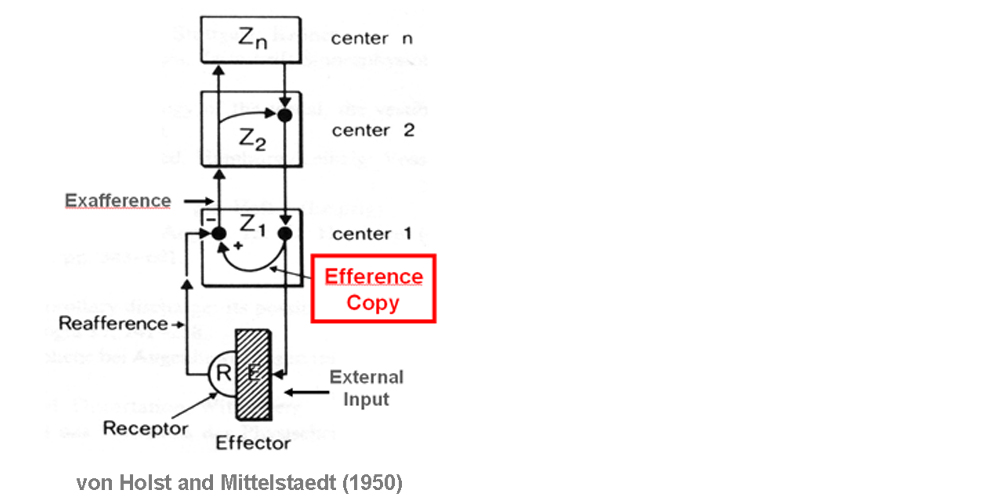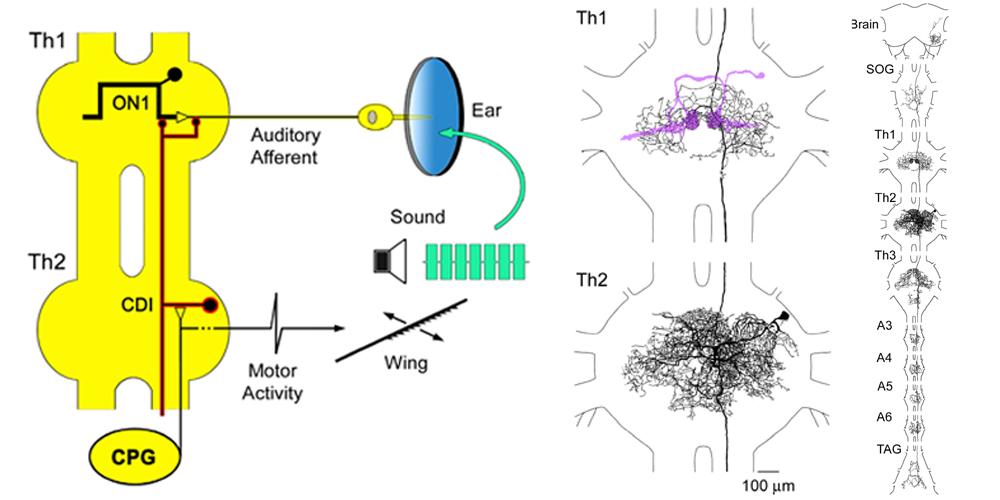Corollary Discharge Mechanisms during Singing
How to Deal with Self-generated Sensory Activity: Corollary Discharges and Efference Copy |
Why can we perceive our environment as stable, although our seeing eyes are moving around? This question puzzled already Greek philosophers and it was only in the 20th century that neural mechanisms i.e. an efference copy (Holst and Mittelstaedt) or a corollary discharge (Sperry) were suggested to provide an appropriate solution.
As a motor command is executed i.e. moving the eyes, the CNS at the same time generates an efference copy/corollary discharge that is send towards the sensory pathway, to interact with the self-generated sensory information. In this way, the self-generated sensory activity can be cancelled or at least modulated and the nervous system, doe not have to process activity that can be predicted from its own action.
Singing crickets provide an excellent system to study this central question of neuronal processing at the cellular level.

A Corollary Discharge Interneuron in Crickets |
How do singing crickets deal with the self-generated sounds, which could desensitize their auditory system? Do they listen to the self-generated sounds in the same way as to sound pulses from the environment?
Analyzing the activity of auditory interneurons in singing males, revealed that the responses to the own song are reduced. Auditory interneurons receive an inhibition at the moment sound pulses are generated and the synaptic transmission between auditory afferents and interneurons is reduced due to primary afferent depolarisation at the axon terminals. The inhibition is mediated by a corollary discharge interneuron (CDI), that runs along the length of the cricket nervous system, and that makes monosynaptic connections to neurons of the auditory pathway. So far, this is the best cellular pathway described for a corollary discharge mechanism.
The CD interneuron is driven by the singing CPG and modulates auditory processing of self-generated sound pulses at the level of afferents and interneurons (left). Structure of the CDI in the cricket CNS.
References:
- Schöneich S and Hedwig B (2015) Corollary discharge inhibition of wind-sensitive cercal giant interneurons in the singing field cricket. J Neurophysiol, 113:390-399; doi:10.1152/jn.00520.2014
- Poulet, JFA and Hedwig B (2006) The cellular basis of a corollary discharge. Science 311: 518-522.
- Poulet, JFA and Hedwig B (2003) A corollary discharge modulates central auditory processing in singing crickets. J Neurophysiol 89: 1528-1540
- Poulet, JFA and Hedwig B (2003) Corollary discharge inhibition of ascending auditory neurons in the stridulating cricket. J Neuroscience 23: 4717-4725
- Poulet JFA, Hedwig B (2002) A corollary discharge maintains auditory sensitivity during sound production. Nature, 418:872-876

